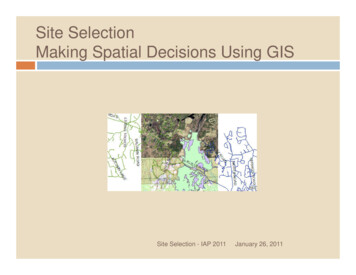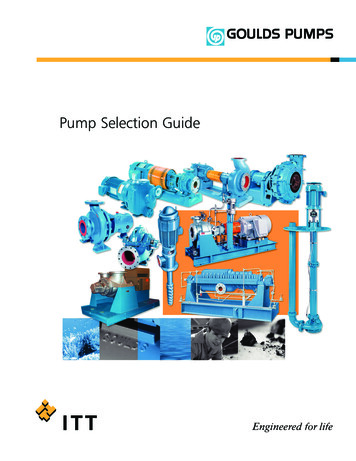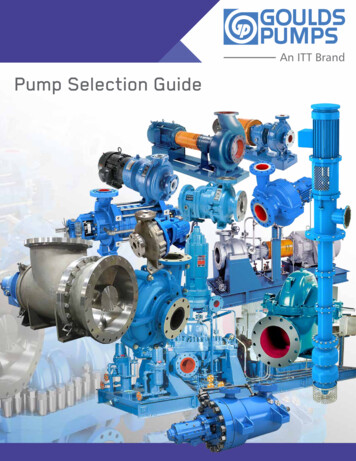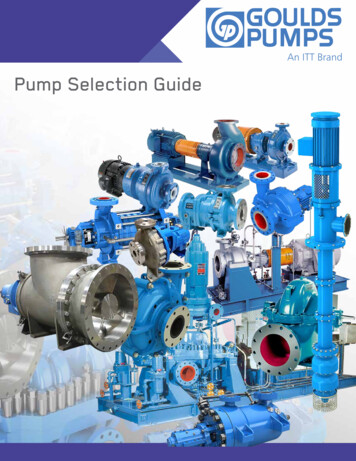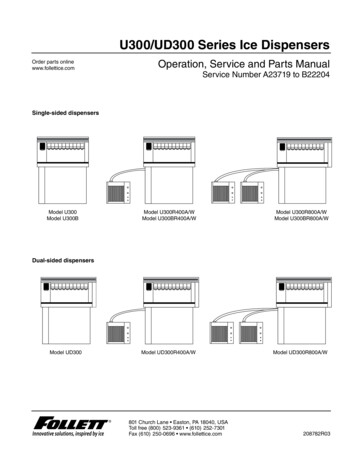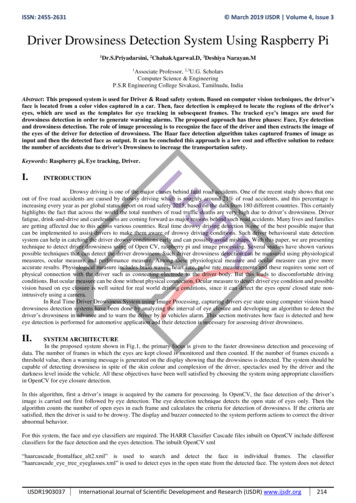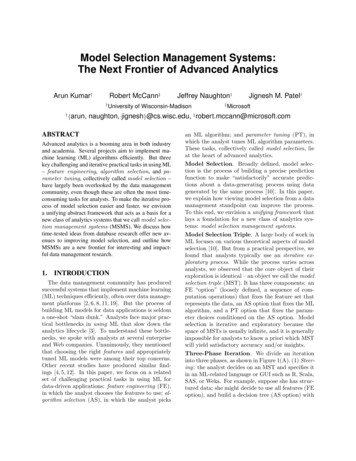
Transcription
Model Selection Management Systems:The Next Frontier of Advanced AnalyticsArun Kumar†Robert McCann‡††{arun,‡University of Wisconsin-MadisonJignesh M. Patel†Microsoft‡naughton, jignesh}@cs.wisc.edu, robert.mccann@microsoft.comABSTRACTAdvanced analytics is a booming area in both industryand academia. Several projects aim to implement machine learning (ML) algorithms efficiently. But threekey challenging and iterative practical tasks in using ML– feature engineering, algorithm selection, and parameter tuning, collectively called model selection –have largely been overlooked by the data managementcommunity, even though these are often the most timeconsuming tasks for analysts. To make the iterative process of model selection easier and faster, we envisiona unifying abstract framework that acts as a basis for anew class of analytics systems that we call model selection management systems (MSMS). We discuss howtime-tested ideas from database research offer new avenues to improving model selection, and outline howMSMSs are a new frontier for interesting and impactful data management research.1.Jeffrey Naughton†INTRODUCTIONThe data management community has producedsuccessful systems that implement machine learning(ML) techniques efficiently, often over data management platforms [2, 6, 8, 11, 19]. But the process ofbuilding ML models for data applications is seldoma one-shot “slam dunk.” Analysts face major practical bottlenecks in using ML that slow down theanalytics lifecycle [3]. To understand these bottlenecks, we spoke with analysts at several enterpriseand Web companies. Unanimously, they mentionedthat choosing the right features and appropriatelytuned ML models were among their top concerns.Other recent studies have produced similar findings [4, 5, 12]. In this paper, we focus on a relatedset of challenging practical tasks in using ML fordata-driven applications: feature engineering (FE),in which the analyst chooses the features to use; algorithm selection (AS), in which the analyst picksan ML algorithm; and parameter tuning (PT), inwhich the analyst tunes ML algorithm parameters.These tasks, collectively called model selection, lieat the heart of advanced analytics.Model Selection. Broadly defined, model selection is the process of building a precise predictionfunction to make “satisfactorily” accurate predictions about a data-generating process using datagenerated by the same process [10]. In this paper,we explain how viewing model selection from a datamanagement standpoint can improve the process.To this end, we envision a unifying framework thatlays a foundation for a new class of analytics systems: model selection management systems.Model Selection Triple. A large body of work inML focuses on various theoretical aspects of modelselection [10]. But from a practical perspective, wefound that analysts typically use an iterative exploratory process. While the process varies acrossanalysts, we observed that the core object of theirexploration is identical – an object we call the modelselection triple (MST). It has three components: anFE “option” (loosely defined, a sequence of computation operations) that fixes the feature set thatrepresents the data, an AS option that fixes the MLalgorithm, and a PT option that fixes the parameter choices conditioned on the AS option. Modelselection is iterative and exploratory because thespace of MSTs is usually infinite, and it is generallyimpossible for analysts to know a priori which MSTwill yield satisfactory accuracy and/or insights.Three-Phase Iteration. We divide an iterationinto three phases, as shown in Figure 1(A). (1) Steering: the analyst decides on an MST and specifies itin an ML-related language or GUI such as R, Scala,SAS, or Weka. For example, suppose she has structured data; she might decide to use all features (FEoption), and build a decision tree (AS option) with
1 Decide and code an MST manuallySteering FE1AS1PT1FE2 X AS2 X PT2 Next iteration3 Consumption(A) Current Approach2 ExecutionEvaluate modelusing system(C) Model Selection Management Systems (MSMS)The Higher Layers:Declarative InterfacesManage results manuallyAutotunedfunctionsColumbusE.g., glmnet() in R E.g., StepAdd()FE x AS x {PT}(B) Our Vision A set of logicallyThe Narrow Waist:1 Declarative specification of MSTsrelated MSTsA set of logically relatedCode Generation{FE1, FE2} x AS2Model Selection Triples (MST)x {PT1, PT2}2 Optimization Evaluate modelsusing systemNext iteration 3 Provenance managementThe Lower Layers:Optimized ImplementationsManage results{FE} x AS x PTMLBaseNew AbstractionsE.g., doClassify() FE x {AS1 x {PT}, AS2 x {PT}} {FE} x AS x {PT}, { {FE} x {AS} x {PT} }In-memoryIn-RDBMSOthersFigure 1: Model Selection. (A) The current dominant approach: the analyst chooses one combination ofoptions for feature engineering (FE), algorithm selection (AS), and parameter tuning (PT); we call it aModel Selection Triple (MST). She iterates by modifying the MST, e.g., altering a parameter, or droppinga feature. (B) Our vision: she groups logically related MSTs, while the system optimizes the computationsand helps manage results across iterations. (C) MSTs act as a unifying abstraction (a “narrow waist”) fora new class of analytics systems that we call Model Selection Management Systems (MSMS).a fixed tree height (PT option). (2) Execution: thesystem executes the MST to build and evaluate theML model, typically on top of a data managementplatform, e.g., an RDBMS or Spark. (3) Consumption: the analyst assesses the results to decide uponthe MST for the next iteration, or stops the process.For example, if the tree is too big, she might reduce the height (PT option changed), or drop somefeatures (FE option changed). Even such minorchanges in MSTs can cause major changes in accuracy and interpretability, and it is generally hardto anticipate such effects. Thus, analysts evaluateseveral MSTs using an iterative process.Alas, most existing ML systems (e.g., [2, 6, 8, 11,19]) force analysts to explore one MST per iteration.This overburdens the analyst, since she has to perform more iterations. Also, since the system is ignorant of the relationship between the MSTs explored,opportunities to speed up Execution are lost, whileConsumption becomes more manual, which causesmore pain for analysts. Our vision aims to mitigatethese issues by providing more systems support toimprove the effectiveness of analysts as well as theefficiency of the iterative process of model selection.Automation Spectrum. A natural first step is toautomate some of the analyst’s work by providinga more holistic view of the process to the system.For example, the system can evaluate decision treeswith all possible heights (PT options), or all subsetsof features (FE options). Clearly, such naive bruteforce automation might be prohibitively expensive,while the analyst’s expertise might be wastefully ignored. On the other hand, if the system hardcodesonly a few sets of MSTs, analysts might deem it toorestrictive to be useful. Ideally, what we want is theflexibility to cover a wide spectrum of automation,in which the analyst controls exactly how much automation she desires for her application. This wouldenable analysts to still use their expertise duringSteering, but push much of the “heavy lifting” tothe system during Execution and Consumption.1.1Our Vision: MSMS to Manage MSTsWe envision a unifying framework that enablesanalysts to easily explore a set of logically relatedMSTs per iteration rather than just one MST periteration. The analyst’s expertise is useful in deciding which MSTs are grouped. Figure 1(B) illustrates our vision. In the figure, the analyst groupsmultiple values of tree height and feature subsets.As we will explain shortly, this ability to handle alogically related set of MSTs all at once is a simplebut powerful unifying abstraction for a new class ofanalytics systems that aim to support the iterativeprocess of model selection. We call such systemsmodel selection management systems (MSMS).Iteration in an MSMS. MSTs are too low-levelfor analysts to enumerate. Thus, an MSMS shouldprovide a higher level of abstraction for specifyingMSTs. A trivial way is to use for loops. But ourvision goes deeper to exploit the full potential ofour idea, by drawing inspiration from the RDBMSphilosophy of handling “queries.” By repurposingthree key ideas from the database literature, anMSMS can make model selection significantly easierand faster. (1) Steering: an MSMS should offer aframework of declarative operations that enable analysts to easily group logically related MSTs. Forexample, the analyst can just “declare” the set oftree heights and feature subsets (projections). The
system generates lower-level code to implicitly enumerate the MSTs encoded by the declarative operations. (2) Execution: an MSMS should includeoptimization techniques to reduce the runtime periteration by exploiting the set-oriented nature ofspecifying MSTs. For example, the system couldshare computations across different parameters orshare intermediate materialized data for differentfeature sets. (3) Consumption: an MSMS shouldoffer provenance management so that the systemcan help the analyst manage results and help withoptimization. For example, the analyst can inspectthe results using standard queries to help steer thenext iteration, while the system can track intermediate data and models for reuse. Overall, an MSMSthat is designed based on our unifying frameworkcan reduce both the number of iterations (by improving Steering and Consumption) and the timeper iteration (by improving Execution).Unifying Narrow Waist. Interestingly, our framework subsumes many prior abstractions that canbe seen as basically restricted MSMS interfaces inhindsight, as shown in Figure 1(C). In a sense, ourabstraction acts as a “narrow waist” for MSMSs.1An MSMS stacks higher layers of abstraction (declarative interfaces) to make it easier to specify sets ofMSTs and lower layers of optimized implementations to exploit the set-oriented nature of specifyingMSTs. We elaborate with three key examples: (1)R provides many autotuned functions, e.g., glmnetfor linear models. These can be viewed as declarative operations to explore multiple PT options,while fixing FE and AS options. (2) Columbus [18]offers declarative operations to explore a set of feature subsets simultaneously. This can be viewed asexploring multiple FE options, while fixing AS andPT options. (3) MLBase [13] fully automates algorithm selection and parameter tuning by hardcoding a small set of ML techniques and tuning heuristics (unlike our vision of handling a wide spectrumof automation). This can be viewed as exploringmultiple combinations of AS and PT options, whilefixing the FE option. Our vision is the distillationof the common thread across such abstractions, andlays a principled foundation for the design and evaluation of model selection management systems.Towards a Unified MSMS. The natural nextstep is to build a unified MSMS that exposes thefull power of our abstraction rather than supporting FE, AS, and PT in a piecemeal fashion. A1Like how IP acts as the “narrow waist” of the Internet.unified MSMS could make it easier for analysts tohandle the whole process in one “program” ratherthan straddling multiple tools. It also enables sharing code for tasks such as cross-validation, which isneeded for each of FE, AS, and PT. However, building a unified MSMS poses research challenges thatdata management researchers are perhaps more familiar with than ML researchers, e.g., the designtrade-offs for declarative languages. A unified MSMSalso requires ideas from data management and ML,e.g., materializing intermediate data, or sharing computations, which requires RDBMS-style cost-basedanalyses of ML algorithms. The data managementcommunity’s expertise in designing query optimizers could be useful here. A caveat is that the threetasks, especially FE, involve a wide variety of operations. It is perhaps infeasible to capture all suchoperations in the first design of a unified MSMS.Thus, any such MSMS must be extensible. Next,we provide more background on FE, AS, and PT.2.MORE BACKGROUNDFeature Engineering (FE) is the process of converting raw data into a precise feature vector thatprovides the domain of the prediction function (alearned ML model) [5]. FE includes a variety ofoptions (a sequence of computational operations),e.g., counting words or selecting a feature subset.Some options, such as subset selection and featureranking, are well studied [9]. FE is considered adomain-specific “black art” [4, 5], mostly because itis influenced by many technical and logistical factors, e.g., data and application properties, accuracy,time, interpretability, and company policies. Unfortunately, there is not much integrated systemssupport for FE, which often forces analysts to writescripts in languages external to data managementsystems, sample and migrate data, create intermediate data, and track their steps manually [4, 12].Such manual effort slows and inhibits exploration.Algorithm Selection (AS) is the process of picking an ML model, i.e., an inductive bias, that fixesthe hypothesis space of prediction functions exploredfor a given application [10]. For example, logistic regression and decision trees are popular MLtechniques for classification applications. Some MLmodels have multiple learning algorithms; for example, logistic regression can use both batch andstochastic gradient methods. Like FE, AS dependson both technical and non-technical factors, whichleads to a combinatorial explosion of choices. Learning ensembles of ML models is also popular [10].
This complexity often forces analysts to iterativelytry multiple ML techniques, which often leads toduplicated effort, and wasted time and resources.Parameter Tuning (PT) is the process of choosing the values of (hyper-)parameters that many MLmodels and algorithms have. For example, logisticregression is typically used with a parameter knownas the regularizer. Such parameters are importantbecause they control accuracy-performance tradeoffs, but tuning them is challenging partly becausethe optimization problems involved are usually nonconvex [10]. Thus, analysts typically perform adhoc manual tuning by iteratively picking a set of values, or by using heuristics such as grid search [10].Some toolkits automate PT for popular ML techniques, which could indeed be useful for some applications. But from our conversations with analysts,we learned that they often tend to avoid such “blackbox” tuning in order to exercise more control overthe accuracy-performance trade-offs.3.RESEARCH CHALLENGES ANDDESIGN TRADE-OFFSWe discuss the key challenges in realizing our vision of a unified MSMS and explain how they leadto novel and interesting research problems in datamanagement. We also outline potential solution approaches, but in order to provide a broader perspective, we explain the design trade-offs involved ratherthan choosing specific approaches.3.1Steering: Declarative InterfaceThe first major challenge is to make it easier foranalysts to specify sets of logically related MSTsusing the power of declarative interface languages.There are two components to this challenge.Language Environment: This component involvesdeciding whether to create a new language or embedded domain-specific languages (DSLs). The former offers more flexibility, but it might isolate usfrom popular language environments such as Python,R, and Scala. A related decision is whether to uselogic or more general dataflow abstractions as thebasis. The latter might be less rigorous but they aremore flexible. The lessons of early MSMSs suggestthat DSLs and dataflow abstractions are preferable;for example, Columbus provides a DSL for R [18].The expertise of the data management communitywith declarative languages will be crucial here.Scope and Extensibility: Identifying the rightdeclarative primitives is a key challenge. Our goalis to capture a wide spectrum of automation. Thus,we need several predefined primitives to hardcodecommon operations for each of FE, AS, and PT aswell as popular ways of combining MSTs. For example, for FE, standardization of features and joinsare common operations, while subset selection is acommon way of combining MSTs. For AS and PT,popular combinations and parameter search heuristics can be supported as first-class primitives, butwe also need primitives that enable analysts to specify custom combinations based on their expertise.Of course, it is unlikely that one language can capture all ML models for AS or all operations for FEand PT. Moreover, different data types (structureddata, text, etc.) need different operations. A pragmatic approach is to start with a set of most common and popular operations as first-class citizensthat are optimized, and then expand systematicallyto include more. Thus, the language needs to be extensible, i.e., support user-defined functions, even ifthey are less optimizable.3.2Execution: OptimizationTo fully exploit declarativity, an MSMS shoulduse the relationship between MSTs to optimize theexecution of each iteration. Faster iterations mightencourage analysts to explore more MSTs, leadingto more insights. This challenge has three aspects.Avoiding Redundancy: Perhaps the most important and interesting aspect is to avoid redundancy in both data movement and computations,since the MSTs grouped together in one iterationare likely to differ only slightly. This idea has beenstudied before, but its full power is yet to be exploited, especially for arbitrary sets of MSTs. Forexample, Columbus [18] demonstrated a handful ofoptimizations for multiple feature sets being groupedtogether during subset selection over structured data.Extending it to other aspects of FE as well as to ASand PT is an open problem. For example, we neednot build a decision tree from scratch for differentheight parameters, if monotonicity is ensured. Another example is sharing computations across different linear models. Redundancy can also be avoidedwithin a single MST; for example, combining theFE option of joins with the AS option of learning alinear model could avoid costly denormalization [15]or even whole input tables [16]. Extending this toother ML models is an open question. Such optimizations require complex performance trade-offsinvolving data and system properties, which mightbe unfamiliar to ML researchers. Thus, the exper-
tise of the data management community in designing cost models and optimizers is crucial here.System Flexibility: This aspect relates to whatlies beneath the declarative language. One approachis to build an MSMS on top of existing data platforms such as Spark, which might make adoptioneasier, but might make it more daunting to includeoptimizations that need changes to the system code.An alternative is to build mostly from scratch, whichwould offer more flexibility but requires more timeand software engineering effort. This underscoresthe importance of optimizations that are genericand easily portable across data platforms.Incorporating Approximation: Many ML models are robust to perturbations in the data and/orthe learning algorithm, e.g., sampling or approximations. While such ideas have been studied fora single MST, new opportunities arise when multiple MSTs are executed together. For example, onecould “warm start” models using models learned ona different feature subset [18]. A more challengingquestion is whether such warm starting is possibleacross different ML models. Finally, new and intuitive mechanisms to enable analysts to trade offtime and accuracy can be studied by asking analyststo provide desired bounds on time or accuracy inthe declarative interface. The system could alter itssearch space on the fly and provide interactive feedback. Exploiting such opportunities requires characterization of new accuracy-performance trade-offs,which might require the data management community to work more closely with ML researchers.3.3Consumption: Managing ProvenanceOperating on more MSTs per iteration means theanalyst needs to consume more results and track theeffects of their choices more carefully. But thanksto declarativity, the system can offer more pervasivehelp for such tasks. This has two aspects.Capture and Storage: The first aspect is to decide what to capture and how to store it. Storinginformation about all MSTs naively might cause unacceptable storage and performance overheads. Forexample, even simple subset selection operations forFE on a dataset with dozens of features might yieldmillions of MSTs. One approach is to design special provenance schemas based on the semantics ofthe declarative operations. Another approach isto design new compression techniques. The analyst might have a key role to play in deciding exactly what needs to be tracked; for example, theymight not be interested in PT-related changes, butmight want to inspect AS- and FE-related changes.Novel applications are possible if these problemsare solved, e.g., auto-completion or recommendation of MST changes to help analysts improve Steering. The expertise of the data management community with managing workflow and data provenancecould be helpful in tackling such problems. Buildingapplications to improve analyst interaction usingprovenance might require more collaboration withthe human-computer interaction (HCI) community.Reuse and Replay: Another aspect is the interaction of provenance with optimization. A key application is avoiding redundancy across iterations byreusing intermediate data and ML models. Such redundancy can arise, since MSTs typically differ onlyslightly across iterations, or if there are multiple analysts. This could involve classically hard problemssuch as relational query equivalence, but also newproblems such as defining hierarchies of “subsumption” among ML models. For example, it is easy toreuse intermediate results for logistic regression ifthe number of iterations is increased by the analyst,but it is non-obvious to decide what to reuse if shedrops some data examples or features. This pointsto the need to characterize a formal notion of “MLprovenance,” which is different from both data andworkflow provenance. The data management community’s expertise with formal provenance modelscould be helpful in tackling this challenge.Summary. Building a unified MSMS to expose thefull power of our abstraction requires tackling challenging research problems, which we outlined withpotential solutions and design trade-offs. Our list isnot comprehensive – other opportunities also exist,e.g., using visualization techniques to make Steeringand Consumption easier. We hope to see more ofsuch interesting new problems in MSMS research.4.EXISTING LANDSCAPEWe now briefly survey the existing landscape ofML systems and discuss how our vision relates tothem. We classify the systems into six categoriesbased on their key goals and functionalities. Due tospace constraints, we provide our survey in a separate report [14], but summarize it in Table 1. Ourtaxonomy is not intended to be exhaustive, but togive a picture of the gaps in the existing landscape.Numerous systems have focused on efficient and/orscalable implementations of ML algorithms and/orR-like languages. Some other systems have focused
CategorySub-categoryStatistical Software PackagesData Mining ToolkitsPackages of SRL FrameworksDescriptionSoftware toolkits with a large set of implementations of MLalgorithms, typically with visualization supportExamplesSAS, R, Matlab, SPSSSoftware toolkits with a relatively limited set of ML algorithms,Weka, AzureML, ODM, MADlib,typically over a data platform, possibly with incremental maintenance Mahout, Hazy-ClassifySoftware frameworks and systems that aim to improve developability,GraphLab, Bismarck, MLBasetypically from academic researchImplementations of statistical relational learning (SRL)DeepDiveImplementations of deep neural networksGoogle Brain, Microsoft AdamBayesian Inference SystemsSystems providing scalable inference for Bayesian ML modelsSimSQL, Elementary, TuffyStatistical Software PackagesSystems offering an interactive statistical programming environmentSAS, R, MatlabSystems that provide R or an R-like language for analytics, typicallyover a data platform, possibly with incremental maintenanceRIOT, ORE, SystemML, LINVIEWModel Management SystemsSystems that provide querying, versioning, and deployment supportSAS, LongView, VeloxSystems for Feature EngineeringSystems that provide abstractions to make feature engineering easierColumbus , DeepDiveSystems for Algorithm SelectionSystems that provide abstractions to make algorithm selection easierMLBase, AzureMLSystems that provide abstractions to make parameter tuning easierSAS, R, MLBase, AzureMLDeep Learning SystemsLinear Algebrabased SystemsR-based Analytics SystemsSystems for Parameter TuningTable 1: Major categories of ML systems surveyed, along with examples from both products and research.It is possible for a system to belong to more than one category, since it could have multiple key goals.on “model management”-related issues, which involve logistical tasks such as deployment and versioning. A few recent systems aim to tackle oneor more of FE, AS, and PT – Columbus, MLBase,DeepDive, and AzureML. However, they either donot abstract the whole process of model selectionas we do, or do not aim to support a wide portionof the automation spectrum. We have already discussed Columbus and MLBase in Section 1. DeepDive provides a declarative language to specify factor graph models and aims to make FE easier [17],but it does not address AS and PT. Automation ofPT using massive parallelism has also been studied [7]. AzureML provides something similar, andit also aims to make it easier to manage ML workflows for algorithm selection [1]. All these projectsprovided the inspiration for our vision. We distilltheir lessons as well as our interactions with analysts into a unifying abstract framework. We alsotake the logical next step of envisioning a unifiedMSMS based on our framework to support FE, AS,and PT in an integrated fashion (Figure 1).5.CONCLUSIONWe argue that it is time for the data managementcommunity to look beyond just implementing MLalgorithms efficiently and help improve the iterativeprocess of model selection, which lies at the heartof using ML for data applications. Our unifyingabstraction of model selection triples acts as a basis for designing a new class of analytics systems tomanage model selection in a holistic and integratedfashion. By leveraging three key ideas from datamanagement research – declarativity, optimization,and provenance – such model selection managementsystems could help make model selection easier andfaster. This could be a promising direction for interesting and impactful research in data management,as well as its intersection with ML and 14][15][16][17][18][19]REFERENCESMicrosoft Azure ML. studio.azureml.net.Oracle R Enterprise. www.oracle.com.SAS Report on Analytics. sas.com/reg/wp/corp/23876.M. Anderson et al. Brainwash: A Data System for FeatureEngineering. In CIDR, 2013.P. Domingos. A Few Useful Things to Know aboutMachine Learning. CACM, 2012.X. Feng et al. Towards a Unified Architecture forin-RDBMS Analytics. In SIGMOD, 2012.Y. Ganjisaffar et al. Distributed Tuning of MachineLearning Algorithms Using MapReduce Clusters. InLDMTA, 2011.A. Ghoting et al. SystemML: Declarative MachineLearning on MapReduce. In ICDE, 2011.I. Guyon et al. Feature Extraction: Foundations andApplications. New York: Springer-Verlag, 2001.T. Hastie et al. Elements of Statistical Learning: Datamining, inference, and prediction. Springer-Verlag, 2001.J. Hellerstein et al. The MADlib Analytics Library orMAD Skills, the SQL. In VLDB, 2012.S. Kandel et al. Enterprise Data Analysis andVisualization: An Interview Study. IEEE TVCG, 2012.T. Kraska et al. MLbase: A Distributed Machine-learningSystem. In CIDR, 2013.A. Kumar et al. A Survey of the Existing Landscape ofML Systems. UW-Madison CS Tech. Rep. TR1827, 2015.A. Kumar et al. Learning Generalized Linear Models OverNormalized Data. In SIGMOD, 2015.A. Kumar et al. To Join or Not to Join? Thinking Twiceabout Joins before Feature Selection. In SIGMOD, 2016.C. Ré et al. Feature Engineering for Knowledge BaseConstruction. IEEE Data Engineering Bulletin, 2014.C. Zhang et al. Materialization Optimizations for FeatureSelection Workloads. In SIGMOD, 2014.Y. Zhang et al. I/O-Efficient Statistical Computing withRIOT. In ICDE, 2010.
Towards a Uni ed MSMS. The natural next step is to build a uni ed MSMS that exposes the full power of our abstraction rather than support-ing FE, AS, and PT in a piecemeal fashion. A 1Like how IP acts as the \narrow waist" of the Internet. uni ed MSMS could make it easier for analysts to handle the whole process in one \program" rather




